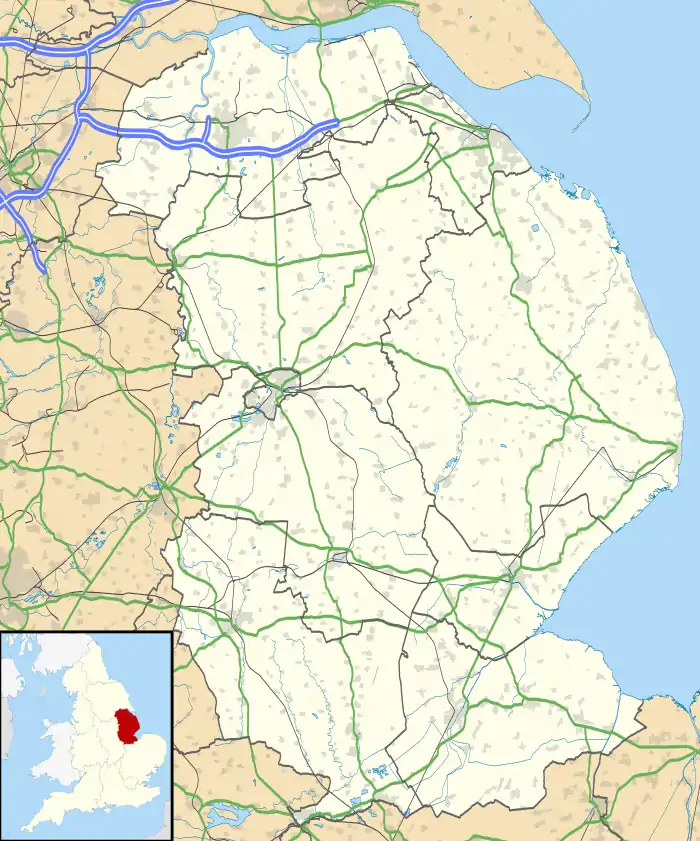| Kirton in Holland Town Hall | |
|---|---|
 Kirton in Holland Town Hall | |
| Location | Station Road, Kirton, Lincolnshire |
| Coordinates | 52°55′39″N 0°03′24″W / 52.9275°N 0.0566°W |
| Built | 1912 |
| Architect | Henry Kidd |
| Architectural style(s) | Châteauesque style |
 Shown in Lincolnshire | |
Kirton in Holland Town Hall is a municipal building in Station Road in Kirton, Lincolnshire, England. The structure is currently used as a community events venue and as the meeting place of Kirton Parish Council.
History
.jpg.webp)
The town hall was commissioned and paid for by a local potato businessman, William Dennis, to commemorate the Coronation of George V and Mary.[1] The site he chose for the new building was open land on the south side of Station Road.[2] The foundation stone for the new building was laid in 1911.[3] It was designed by Henry Kidd in the Châteauesque style, built in red brick and was officially opened by Baroness von Eckardstein[lower-alpha 1] in August 1912.[5]
The design involved a symmetrical main frontage with seven bays facing onto Station Road. The central bay, which slightly projected forward, featured a two-stage tower; there was a doorway flanked by pilasters supporting a foundation stone and a pediment in the first stage, two small pedimented windows in the second stage and a mansard roof and an iron crown above.[6] The second bays on both sides were fenestrated by pedimented bay windows while the other bays were fenestrated by pedimented sash windows. The building was subsequently extended with a four-bay extension to the left and a single bay extension to the right. Internally, the principal rooms were the main assembly hall and a smaller reception room, known as the Upsall Room, which became the meeting place of Kirton Parish Council.[7]
A statue to commemorate the life of the benefactor, William Dennis, was designed by Philip Lindsey Clark and was unveiled in front of the town hall in 1930.[8][9][10]
The Upsall Room and the entrance hall were refurbished in the early 21st century and the management of the town hall was transferred to a committee of local residents and users which was registered as a charity in 2007.[11][12] A recipe book was published by the town hall management committee in June 2011 to commemorate the centenary of the completion of the town hall.[13][14]
Notes
- ↑ Baroness von Eckardstein was the daughter of the furniture businessman, Sir John Blundell Maple, and the wife of the local member of parliament, Sir Archibald Weigall.[4]
References
- ↑ "Kirton". Visitoruk.com. Retrieved 20 February 2022.
- ↑ "Ordnance Survey Map". 1885. Retrieved 20 February 2022.
- ↑ Foundation stone above the front door (Stone). 1911.
- ↑ "Weigall, Sir William Ernest George Archibald (1874–1952)". Australian Dictionary of Biography. Retrieved 20 February 2022.
- ↑ "Timeline History of Boston". Visitoruk.com. Retrieved 20 February 2022.
- ↑ Pevsner, Nikolaus; Harris, John; Antram, Nicholas (1989). Lincolnshire (Buildings of England Series). Yale University Press. p. 421. ISBN 978-0300096200.
- ↑ "Parish Council Meeting Agenda". Kirton Parish Council. 23 November 2021. Retrieved 20 February 2022.
- ↑ Historic England. "Statue to William Dennis, in front of Kirton Town Hall, Station Road (1165276)". National Heritage List for England. Retrieved 20 February 2022.
- ↑ "Philip Lindsey Clark". Glasgow - City of Sculpture. Retrieved 20 February 2022.
- ↑ Lindsey Clark, Philip. "William Dennis (1841–1924)". Art UK. Retrieved 20 February 2022.
- ↑ "Kirton Parish Plan". Kirton News Online. 1 October 2007. Retrieved 20 February 2022.
- ↑ "Kirton Town Hall Management Committee". Charities Commission. Retrieved 20 February 2022.
- ↑ "Kirton Town Hall Recipe Book". Heritage Lincolnshire. Retrieved 20 February 2022.
- ↑ Kirton Town Hall Recipe Book. Kirton Town Hall Management Committee. 2011. ISBN 978-1849835510.